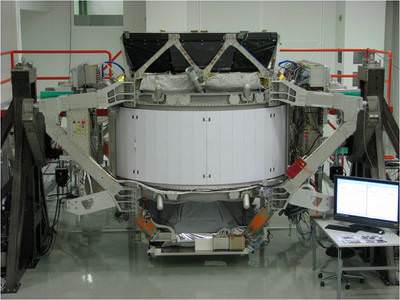[/caption]
The long-awaited experiment that will search for dark matter is getting closer to heading to the International Space Station. The Alpha Magnetic Spectrometer (AMS) is undergoing final testing at ESA's Test Centre in the Netherlands before being launched on the space shuttle to the
ISS
, currently scheduled for July, 2010. The AMS will help scientists better understand the fundamental issues on the origin and structure of the Universe by observing dark matter, missing matter and antimatter. As a byproduct, AMS will gather other information from cosmic radiation sources such as stars and galaxies millions of light years from our home galaxy.
ISS officials have been touting that science is now beginning to be done in earnest on the orbiting laboratory. The AMS will be a giant leap in science capability for the ISS. Not only is it the biggest scientific instrument to be installed on the International Space Station (ISS), but also it is the first magnetic spectrometer to be flown in space, and the largest cryogenically cooled superconducting magnet ever used in space. It will be installed on the central truss of the ISS.
AMS had been cut from the ISS program following the 2003 Columbia shuttle accident, but the outcry over the cancellation forced NASA to rethink their decision. Most of AMS's $1.5-billion costs have been picked up the international partners that NASA wishes to stay on good terms with. 56 institutes from 16 countries have contributed to the AMS project, with Nobel laureate Samuel Ting coordinating the effort.
In an interview with the BBC, Ting said results from AMS may take up to three years to search for antimatter in other galaxies, and dark matter in our own.
The instrument was built at the European Organization for Nuclear Research (CERN) in Geneva, Switzerland. The first part of the tests was also conducted at CERN, when the detector was put through its paces using a proton beam from CERN's Super Proton Synchrotron accelerator to check its momentum resolution and its ability to measure particle curvature and momentum.
AMS's ability to distinguish electrons from protons was also tested. This is very important for the measurement of cosmic rays, 90% of which are protons and constitute a natural background for other signals that interest scientists. AMS will be looking for an abundance of positrons and electrons from space, one of the possible markers for dark matter.
Once the extensive testing is complete, AMS will leave ESTEC at the end of May on a special US Air Force flight to Kennedy Space Center in Florida. It will be launched to the ISS on the Space Shuttle Endeavour on flight STS-134, now scheduled for July.
Source:
ESA
 Universe Today
Universe Today
